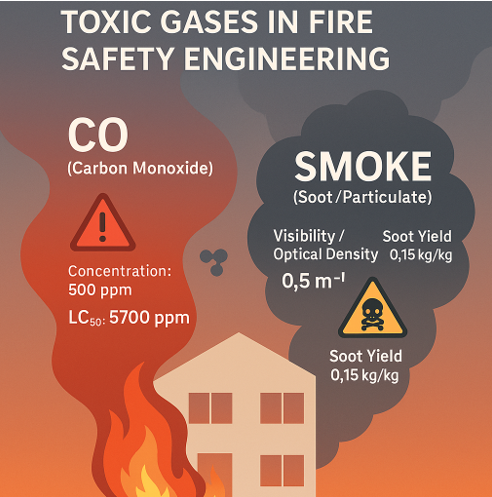
In fire safety engineering, it is essential to recognise that while low visibility due to smoke does not directly cause fatalities, it greatly impairs occupants’ ability to evacuate quickly. The resulting delay in egress increases exposure to toxic combustion products—the leading cause of fire-related deaths. At Lava Consultants, we incorporate CFD fire simulations using Fire Dynamics Simulator (FDS) to analyse toxic gas concentrations and evacuation safety.
When materials burn, they release a combination of hazardous gases and particles. These are generally classified into:
The most critical toxic gases encountered during fires are carbon monoxide (CO) and hydrogen cyanide (HCN). Both are powerful asphyxiants. CO is particularly dangerous because it binds with haemoglobin to form carboxyhaemoglobin, reducing oxygen transport in the blood. Even short-term exposure can lead to loss of consciousness or death.
To evaluate the impact of toxic gases, fire safety engineers use the Fractional Effective Dose (FED)—a life safety metric developed by Dr David A. Purser. FED calculations estimate the cumulative exposure of occupants to toxic gases over time and predict the likelihood of incapacitation.
In performance-based design, FED CO is often calculated using Fire Dynamics Simulator (FDS), supported by formulas from the SFPE Handbook of Fire Protection Engineering and the FDS User Guide. These equations factor in occupant metabolic rate and breathing activity to provide accurate modelling of gas uptake.
FED is a critical output in fire and smoke modelling services, used to determine whether occupants can safely evacuate a space. According to ISO 13571, FED values correlate with expected population response:
FED Range | Expected Incapacitation (%) |
< 0.3 | < 11% |
0.3 – 1 | 11 – 50% |
1 – 3 | 50 – 89% |
> 3 | > 89% |
This data helps engineers set tenability limits for evacuation routes and safe zones in buildings. It is particularly relevant for high-risk areas such as metro stations, tunnels, stadiums, and assembly buildings, where crowd exposure to toxic gases must be tightly controlled.
As a leading fire modelling consultancy in the UAE and Saudi Arabia, Lava Consultants integrates toxic gas simulation, FED CO assessment, and Pathfinder egress modelling into holistic fire safety design strategies. We use tools like PyroSim and FDS to simulate:
Our models are used to support performance-based fire engineering solutions, demonstrate compliance with Civil Defence requirements, and safeguard lives through evidence-based fire safety design.
Understanding the interaction between smoke visibility, toxic gas exposure, and evacuation timing is essential for modern fire safety design. By accurately calculating FED CO and integrating it into CFD fire simulations, engineers can improve evacuation outcomes and enhance life safety.
At Lava Consultants, our expertise in fire and smoke modelling, fire safety simulation, and performance-based design ensures that every project we undertake is backed by robust engineering and international best practices.
© 2025 Lava Consultants. All rights reserved